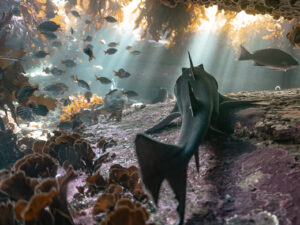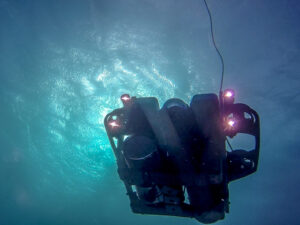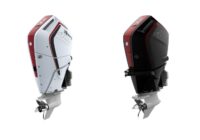Researchers are using a mini submersible camera to conduct a sea life census within NSW Aquatic Reserves.

An underwater census of sea life will add to knowledge of the plants, animals and habitats found within NSW Aquatic Reserves (Photo by Alejandro Trevino)
NSW Department of Primary Industries (DPI) Fisheries Research Scientist Dr Matt Rees said the underwater surveys would help document marine biodiversity within the aquatic reserves.
“A company specialising in using mini remotely operated vehicles (ROVs) for marine research has been engaged to collect the underwater footage. This information will add to our knowledge of the plants, animals and habitats found at the reserves,” Mr Rees said.
“The underwater surveys will be repeated in the future to help us track the ongoing condition of the marine environment at these locations, ” he said.

Researchers are using a mini submersible camera to conduct a sea life census within NSW Aquatic Reserves (Photo by Undersea ROV)
Senior Manager Marine Estate Planning, Lesley Diver, said the sea life census was being carried out at a special moment in the history of the NSW Aquatic Reserves and would improve understanding of some of the marine life they help protect.
“These underwater surveys coincide with significant anniversaries for nine aquatics reserves this year, with three turning 40 years old and six turning 20,” Ms Diver said.
“The first aquatic reserve in NSW at Long Reef on Sydney’s northern beaches was once described as a ‘living museum’, but this description applies to all 12 reserves.
“The primary purpose of the aquatic reserves is to conserve marine biodiversity in those areas, including the variety of habitats.
“Across the twelve aquatic reserves in NSW, the marine habitats represented include mangroves, rocky reefs, forests of different algae including kelp, seagrass beds, sponge gardens, rock platforms, coral reefs, sandy environments, mud flats and natural oyster reefs.
“Aquatic reserves are also important for current and future generations to appreciate and learn about the marine life we have in NSW,” Ms Diver said.
People can help conserve these areas by following the rules and reporting illegal activities – details are on the DPI Fisheries website.
The underwater video surveys are funded through the NSW Government’s 10-year Marine Estate Management Strategy.







